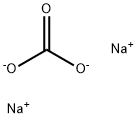Cromolyn Disodium Salt
Synonym(s):Cromoglycate;Cromoglycic acid;Cromolyn sodium salt
- CAS NO.:15826-37-6
- Empirical Formula: C23H17NaO11
- Molecular Weight: 492.37
- MDL number: MFCD00057744
- EINECS: 239-926-7
- SAFETY DATA SHEET (SDS)
- Update Date: 2025-12-23 21:30:31

What is Cromolyn Disodium Salt?
Description
Disodium cromoglycateis a relatively nontoxic agent used for the long-term prevention of many types of asthma. It has no bronchodilator properties and is used in the prophylaxis of asthma. It does not play a role in the treatment of acute asthmatic attacks including severe asthma.
Chemical properties
White Crystalline Powder
Originator
Intal,Fisons,UK,1969
The Uses of Cromolyn Disodium Salt
Chromone complex which blocks mast cell degranulation
The Uses of Cromolyn Disodium Salt
antiasthmatic, antiallergy
The Uses of Cromolyn Disodium Salt
Anti Asthamatic
What are the applications of Application
Cromolyn disodium salt is a compound that blocks the release of pro-inflammatory mediators
Definition
ChEBI: An organic sodium salt that is the disodium salt of cromoglycic acid.
Indications
Cromolyn sodium (Intal) is chemically related drugs called chromones that is used for the prophylaxis of mild or moderate asthma. It is administered by inhalation and has very good safety profiles, making them particularly useful in treating children.
Manufacturing Process
To a solution of 970 parts of 2,6-dihydroxyacetophenone and 325 parts of
epichlorohydrin in 1,500 parts of hot isopropanol was added, with stirring under reflux, a solution of 233 parts of 85% KOH in 2,500 parts of
isopropanol and sufficient water (ca 100 parts) to dissolve the solid. The
mixture was heated, with stirring, under reflux for 48 hours. Half the solvent
was then distilled off and 5,000 parts of water were added. The mixture was
cooled and the solid filtered off and washed with isopropanol and ether. It was
then recrystallized from 12,500 parts of isopropanol to obtain a first crop of
380 parts and a second crop, after concentration, of 300 parts of 1,3-bis(2-
acetyl-3-hydroxyphenoxy)-2hydroxypropane.
4.6 parts of 1,3-bis(2-acetyl-3-hydroxyphenoxy)-2-hydroxypropane were
reacted with diethyl oxalate and the product cyclized to obtain 4.4 parts of
pure diethyl ester of 1,3-bis(2-carboxychromon-5-yloxy)-2-hydroxypropane as
pale yellow crystals melting between 180° and 182°C from a mixture of
benzene and petrol, 4 parts of the diethyl ester of 1,3-bis(2-carboxychromon5-yloxy)-2-hydroxypropane were saponified with sodium hydroxide to obtain
3.2 parts of the disodium salt tetrahydrate as colorless crystals from aqueous
alcohol.
Therapeutic Function
Bronchodilator
General Description
Cromolyn sodium, disodium 1,3-bis(2-carboxychromon-5-yloxy)-2-hydroxypropane (Intal), isa hygroscopic, white, hydrated crystalline powder that is solublein water (1:10). It is tasteless at first but leaves a veryslightly bitter aftertaste. The pK of cromolyn is 2. It is availableas a solution for a nebulizer, an aerosol spray, a nasal solution,an ophthalmic solution, and an oral concentrate.
Nebulized and aerosol cromolyn has been used for prophylacticmanagement of bronchial asthma and prevention ofexercise-induced bronchospasm. Cromolyn nasal solution isused for the prevention and treatment of allergic rhinitis, andoral concentrate is used to treat the histaminic symptomsof mastocytosis (diarrhea, flushing, headaches, vomiting, urticaria,abdominal pain, nausea, and itching). Topical cromolyn(eye drops) is used to treat allergic conjunctivitis andkeratitis. In the treatment of asthma, cromolyn efficacy is manifestedby decreased severity of clinical symptoms, or need for concomitant therapy, or both. Long-term use is justified if thedrug significantly reduces the severity of asthma symptoms;permits a significant reduction in, or elimination of, steroiddosage; or improves management of those who have intolerableside effects to sympathomimetic agents or methylxanthines.For cromolyn to be effective, it must be administered atleast 30 minutes prior to antigen challenge and administered atregular intervals (see dosing information that follows). Wheninhaled, the powder does produce irritation in some patients.Also, overuse of cromolyn can result in tolerance.
Biochem/physiol Actions
Cromolyn blocks the release of histamine and other pro-inflammatory mediators from mast cells.
Mechanism of action
The precise mechanism or mechanisms whereby cromolyn sodium and nedocromil sodium exert their antiasthmatic activities is unknown. Early work suggested that these agents act by “stabilizing” mast cells, preventing mediator release. However, several other compounds exhibit greater potency for stabilization of mast cells yet possess no clinical efficacy in asthma.This suggests that the therapeutic activity of cromolyn sodium and nedocromil sodium in asthma is related to one or more other pharmacological mechanisms. Postulates include inhibitory effects on irritant receptors, nerves, plasma exudation, and inflammatory cells in general.
Pharmacokinetics
Cromolyn sodium is a bischromone that contains the fundamental benzopyrone moiety of khellin. The two chromone rings are necessary for activity and must be coplanar, with a linking chain of no longer than six carbons. If one changes the linking chain to positions 8 and 8′, coplanarity cannot be maintained, and the compound loses all activity. Cromolyn sodium is poorly absorbed from the lungs (~8%), insignificantly from the eye (~0.07%), and by approximately 1% from the GI tract. What little that finds its way into systemic circulation is eliminated intact in the urine and the bile. For the treatment of asthma, cromolyn sodium is available as a solution for both intranasal and inhalation administration. There also is an oral concentrate (100 mg/5 mL), which is administered as a 200-mg dose given four times a day.
Clinical Use
Cromolyn sodium is used almost exclusively for the prophylactic treatment of mild to moderate asthma and should not be used for the control of acute bronchospasm. This agent is effective in about 60 to 70% of children and adolescents with asthma. Unfortunately, there is no reliable means to predict which patients will respond.It is less effective in older patients and in patients with severe asthma. It may take up to 4 to 6 weeks of treatment for cromolyn sodium to be effective in chronic asthma, but it is effective after a single dose in exercise-induced asthma. With respect to clinical efficacy, cromolyn sodium and nedocromil sodium do not differ in a substantial way.
Side Effects
Cromolyn sodium is the least toxic of available therapies for asthma. Adverse reactions are rare and generally minor. Those occurring in fewer than 1 in 10,000 patients include transient bronchospasm, cough or wheezing, dryness of throat, laryngeal edema, swollen parotid gland, angioedema, joint swelling and pain, dizziness, dysuria, nausea, headache, nasal congestion, rash, and urticaria.
Storage
Store at RT
Properties of Cromolyn Disodium Salt
| Melting point: | 241-2420C (dec) |
| storage temp. | 2-8°C |
| solubility | Soluble in water, practically insoluble in ethanol (96 per cent). |
| form | neat |
| form | Solid |
| color | White to Off-White |
| Water Solubility | Soluble in water to 100mg/ml |
| Merck | 14,2590 |
| Stability: | Hygroscopyc |
| CAS DataBase Reference | 15826-37-6(CAS DataBase Reference) |
Safety information for Cromolyn Disodium Salt
| Signal word | Warning |
| Pictogram(s) |
 Exclamation Mark Irritant GHS07 |
| GHS Hazard Statements |
H315:Skin corrosion/irritation H319:Serious eye damage/eye irritation H335:Specific target organ toxicity, single exposure;Respiratory tract irritation |
| Precautionary Statement Codes |
P305+P351+P338:IF IN EYES: Rinse cautiously with water for several minutes. Remove contact lenses, if present and easy to do. Continuerinsing. |
Computed Descriptors for Cromolyn Disodium Salt
| InChIKey | VLARUOGDXDTHEH-UHFFFAOYSA-L |
Cromolyn Disodium Salt manufacturer
New Products
Indole Methyl Resin tert-butyl 9-methoxy-3-azaspiro[5.5]undecane-3-carboxylate Boc-His(Boc)-OH 2-CTC Resin 4-Chloro-7-tosy1-7Hpyrrolo[2,3-d]pyrimidine 5,7-Dibromo-1H-indole 2,5-dichloro-N-hydroxy-4,6-dimethylpyridine-3-carboximidamide 2,2-Dimethoxy-7-azaspiro[3.5]nonane hydrochloride 4-chloromethyl-5-methyl-1,3-dioxol-2-one (DMDO-Cl) R-2-BENZYLOXY PROPIONIC ACID 1,1’-CARBONYLDIIMIDAZOLE 1,1’-CARBONYLDI (1,2-4 TRIAZOLE) N-METHYL INDAZOLE-3-CARBOXYLIC ACID 4-((2-hydroxyethyl)thio)benzoic acid 1-(TERT-BUTOXYCARBONYL)-2-PYRROLIDINONE Methyl 6-methylnicotinate 3-Pyridineacrylic acid tert-Butyl carbazate TETRAHYDRO-2H-PYRAN-3-OL 2-((4-morpholinophenylamino) (methylthio) methylene) malononitrile 3-(4-morpholinophenylamino)-5-amino-1H-pyrazole-4-carbonitrile 2,4-dihydroxybenzaldehyde 1,3-Diethyl-1,3-Diphenylurea Methyl 2-methylquinoline-6-carboxylateRelated products of tetrahydrofuran








You may like
-
 15826-37-6 Disodium cromoglycate 98%View Details
15826-37-6 Disodium cromoglycate 98%View Details
15826-37-6 -
 CROMOLYN SODIUM USP 99%View Details
CROMOLYN SODIUM USP 99%View Details -
 Disodium cromoglycate 15826-37-6 99%View Details
Disodium cromoglycate 15826-37-6 99%View Details
15826-37-6 -
 Cromolyn sodium salt CAS 15826-37-6View Details
Cromolyn sodium salt CAS 15826-37-6View Details
15826-37-6 -
 Cromolyn disodium salt hydrate 95% CAS 15826-37-6View Details
Cromolyn disodium salt hydrate 95% CAS 15826-37-6View Details
15826-37-6 -
 Cromolyn Disodium Salt CAS 15826-37-6View Details
Cromolyn Disodium Salt CAS 15826-37-6View Details
15826-37-6 -
 Cromolyn sodium CAS 15826-37-6View Details
Cromolyn sodium CAS 15826-37-6View Details
15826-37-6 -
 Sodium Cromoglycate CAS 15826-37-6View Details
Sodium Cromoglycate CAS 15826-37-6View Details
15826-37-6
